Early Summer Roe Deer Project 2020
Welcome once again to my annual early summer Roe deer project, which was accomplished this year by cycling 52 miles on five round trips to a reliable site on the Sussex/Surrey border. In previous years, I caught the train to a nearby station and cycled to the nature reserve, but since I am not allowed to use public transport for non-essential journeys, cycling is my only available option. I was nervous about travelling so far by bicycle, due to the risk of coming home with nothing. The free time people have during the lockdown increased the chance of human presence in late evening, just at a time when the deer normally emerge to make the most of the short summer nights. Fortunately, local people here are considerate and they used alternative routes when I signalled to them that wildlife photography was underway. Although the holiday segment of my project began in good weather, Atlantic low pressure systems led to frustration at cancelled trips. I had to schedule visits on my days off to make up for these losses.
By the third and forth visits, it felt obvious that the cycle journey was becoming routine. My fitness and stamina are much improved and I require fewer stops to rest. Since the new year, I've dropped from 95kg to 81kg and my leg muscles are becoming enlarged. I might keep this up, even when public transport restrictions are eased. Nonetheless, the e-bike and payload is four times heavier than a road bike. I can drink 8 litres of water in a single day and still get dehydrated — inland parts of Sussex, even on an average summer day, are much warmer than Brighton. Carrying heavy equipment around the reserve for several hours and getting home at 11:30pm took a lot out of me. I've benefited from days off afterwards, as have the deer. They would have quickly become wary of my presence, had I kept turning up night after night, intruding on their activity.
By the third and forth visits, it felt obvious that the cycle journey was becoming routine. My fitness and stamina are much improved and I require fewer stops to rest. Since the new year, I've dropped from 95kg to 81kg and my leg muscles are becoming enlarged. I might keep this up, even when public transport restrictions are eased. Nonetheless, the e-bike and payload is four times heavier than a road bike. I can drink 8 litres of water in a single day and still get dehydrated — inland parts of Sussex, even on an average summer day, are much warmer than Brighton. Carrying heavy equipment around the reserve for several hours and getting home at 11:30pm took a lot out of me. I've benefited from days off afterwards, as have the deer. They would have quickly become wary of my presence, had I kept turning up night after night, intruding on their activity.

The appearance of this A-List couple in the most attractive part of the meadow was a dream come true. I love how the buck is standing in a gap, as all too often long grasses prevent a clean view. They were briefly distracted by two walkers out for a late stroll and I used this opportunity to get closer. Just like human partners, they displayed 'couple behaviour', such as mirrored body language. Their reactions, travel and body movements were closely linked. The mature buck still hadn't fully shed his winter coat, but he had a fine set of near-symmetrical antlers. I was lucky enough to accidentally tread on a naturally fallen antler here last summer. I took the antler home and after a thorough cleaning, it is now kept in my living room.
Approaching rain clouds tricked this young, inexperienced doe into thinking it was dusk. She looked nervous for a minute, but she quickly realised I posed no threat and set about looking for oak leaves growing on saplings. Roe deer dislike uncertainty and wildlife photographers hiding behind bushes is the quickest way to make them nervous. If Roe deer can see you are not a threat, they will quickly lose interest. In August 2018, I spent three visits at another site encouraging a young buck to become used to me and I finally managed to sit for half-an-hour within twenty metres of him. The buck even dozed off at one point. When I've presented myself to Roe deer in plain sight, built up a degree of trust and left the scene with the deer feeling calm, I feel like I have earned my right to photograph them.
If you look at the first picture of the doe eyeing up the oak leaves, you can see how focussed she is, almost like a human staring at a plate of chocolate biscuits. Her body language relaxes slightly in the second picture, as she eats, but she remains focussed on the other leaves. Roe deer are very choosy eaters. I've seen them travel distances over meadows, looking for the most nutritious plants. They are particularly fond of oak leaves and buttercups. And they would eat your garden, too, if you didn't protect it with a fence!
After about ten minutes, two groups of walkers appeared, but they exercised restraint when I signalled to them. The size of my lens gave away that something important was happening! I could see the walkers getting their binoculars out to watch the deer from their own vantage points. It was refreshing to see locals in this part of Sussex showing restraint and instead using the opportunity to observe the wildlife for themselves. All too often, in Brighton, residents just walk straight in-front of the camera, frightening the birds and butterflies they too could have enjoyed watching.
I didn't realise it at the time, but I photographed this doe before, in 2016, 2018 and 2019. She is quite laid back for a doe (mothers with young to protect take fewer risks). The doe stopped to look back, before grooming herself and walking off to a neighbouring field. I was so close, that the first picture is full frame and the other two are only slightly cropped. I've started seeing the benefits of the 'silent drive' mode on my camera. The mirror return 'click' in DSLR cameras is the primary reason for making wild animals tense and alert in pictures. The silent mode slows the mirror return speed inside the camera, creating a much softer and quieter sound. The second factor improving my chances of recording natural behaviour is due to the extra 200mm reach from my Canon EF 1.4x MKIII teleconverter. I can stay within the deer's comfort zone and still take high resolution shots, with minimal cropping. The roe deer subsequently spend more time engaging in their natural behaviour, instead of poking their heads up in alarm every time the shutter goes off or losing their nerve, because I am too close.
In this sequence, we can see the doe's natural behaviour of keeping her head down, to avoid being seen by predators. She was also focussed on potential food sources. The doe stopped, when she saw me, but since I did not give off any predatory behaviour, she lost interest. Foxes bolt very quickly with rare exception when disturbed. Their high calorie meals (small mammals and birds) provide sufficient energy for a quick, immediate departure, but if you're a Roe deer, an hour of foraging may only amount to the same calories from a bag of salad. Roe deer lack body fat reserves and their diet is low in calories, so they won't waste energy running away if they don't have to.
In this sequence, we can see the doe's natural behaviour of keeping her head down, to avoid being seen by predators. She was also focussed on potential food sources. The doe stopped, when she saw me, but since I did not give off any predatory behaviour, she lost interest. Foxes bolt very quickly with rare exception when disturbed. Their high calorie meals (small mammals and birds) provide sufficient energy for a quick, immediate departure, but if you're a Roe deer, an hour of foraging may only amount to the same calories from a bag of salad. Roe deer lack body fat reserves and their diet is low in calories, so they won't waste energy running away if they don't have to.


Roe deer normally avoid grazing in fields occupied by domesticated animals, after all, who could blame them for not wanting to eat plants tainted by animal droppings and urine? This doe, seen earlier, fixating on buttercups, finally ventured into the horse field, after rain fell overnight and during the afternoon, cleansing the buttercups. I've often seen roe using their long necks to reach up and eat leaves on branches, but this was the first time I had been close enough to get a picture.
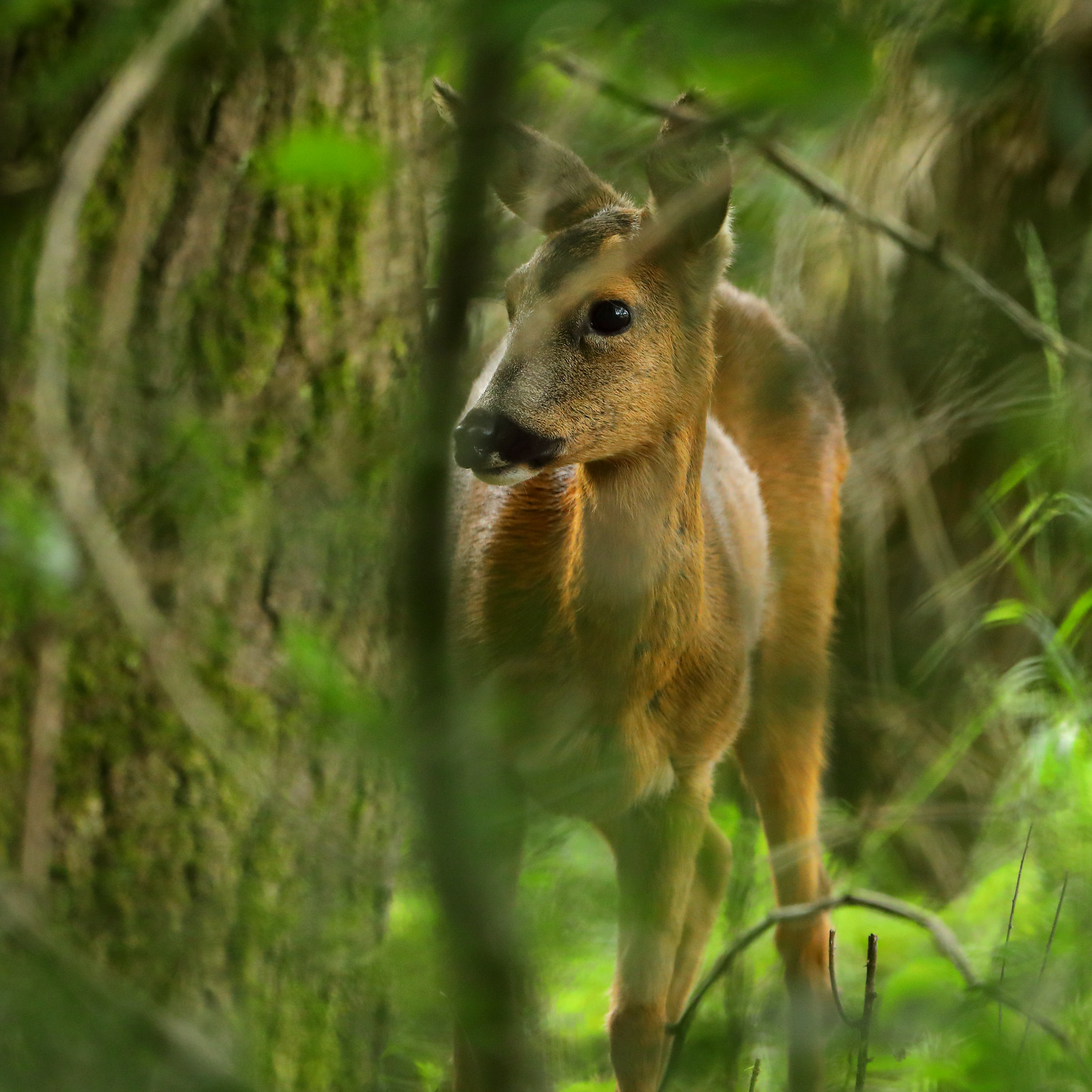
I'd seen another young doe eating buttercups at the edge of a smaller pasture, before disappearing into the trees. I wandered over, to check if she'd walked into the meadows opposite. My ability to avoid stepping on twigs or accidentally bang my tripod legs on tree trunks has improved since May. I get out of practice over the winter! There she was, biding her time in the trees. She noticed me eventually, but wandered off after working out I wasn't a threat.
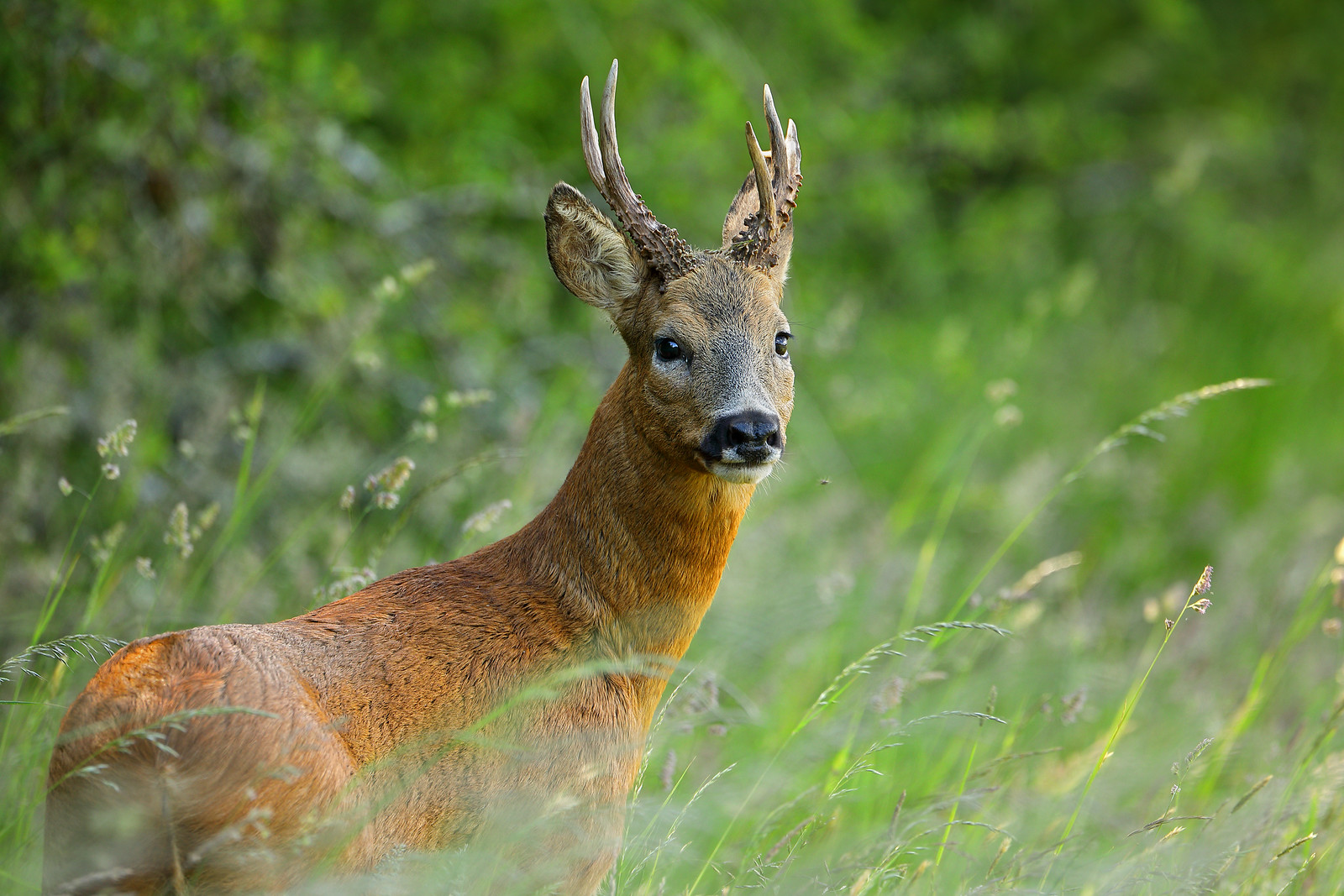
My fifth visit documented the arrival of a mature buck with three-pronged antlers. His behaviour reminded me of that younger male deer I photographed at another site in August 2018. He was one of those relatively uncommon bucks, who stood his ground and remained quite indifferent, even when I was 20 metres away in plain sight. I unexpectedly encountered this mature buck at the edge of a small wooded area. He turned up again in late evening in an open meadow. I could see him through the long grass and he occasionally looked back at me, despite being very close. This is his territory now. The buck is not going to waste energy moving, just because I am here. But, he did finally get up. More on this later.
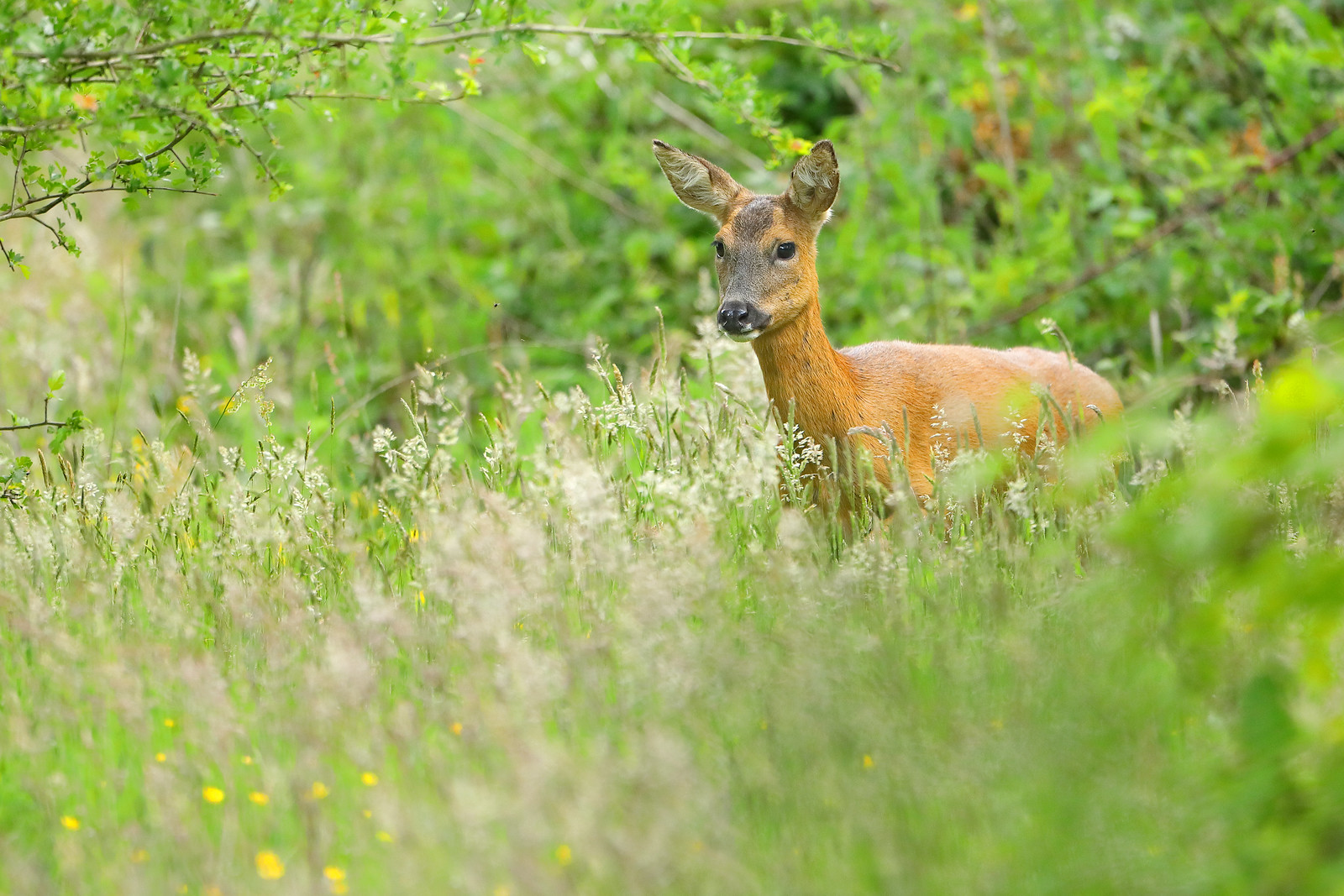
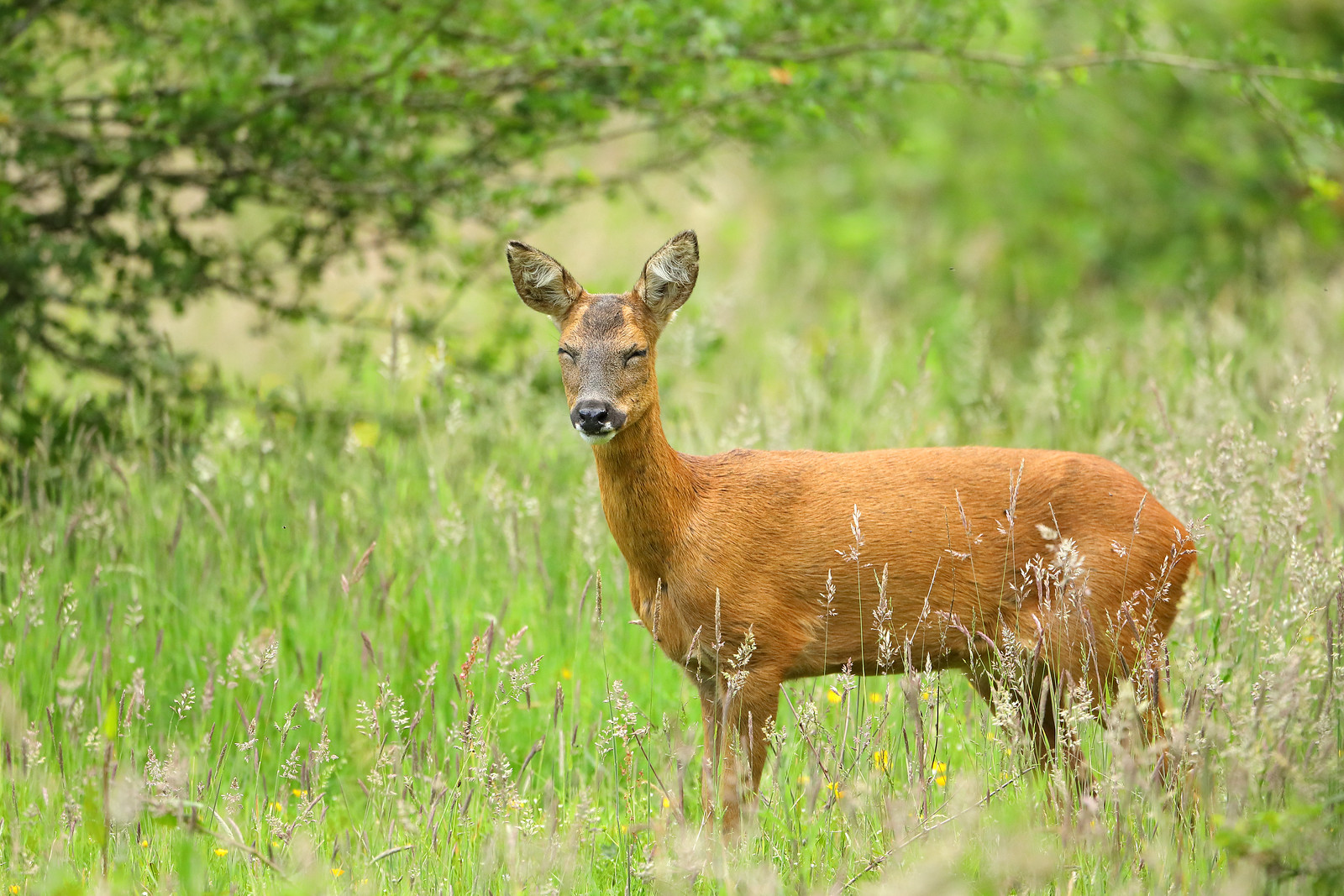

This doe appeared in a quiet spot, popular with deer wanting to browse for leaves without being disturbed. The small meadow is adjacent to a wildlife corridor between fields and acts as a route for deer bypassing areas where disturbance from people is likely. The network of corridors enables deer to travel from one side of the reserve to another, completely unnoticed, as in the case of the mature buck who used the secret routes, reappearing a good 400 metres from where I first saw him.
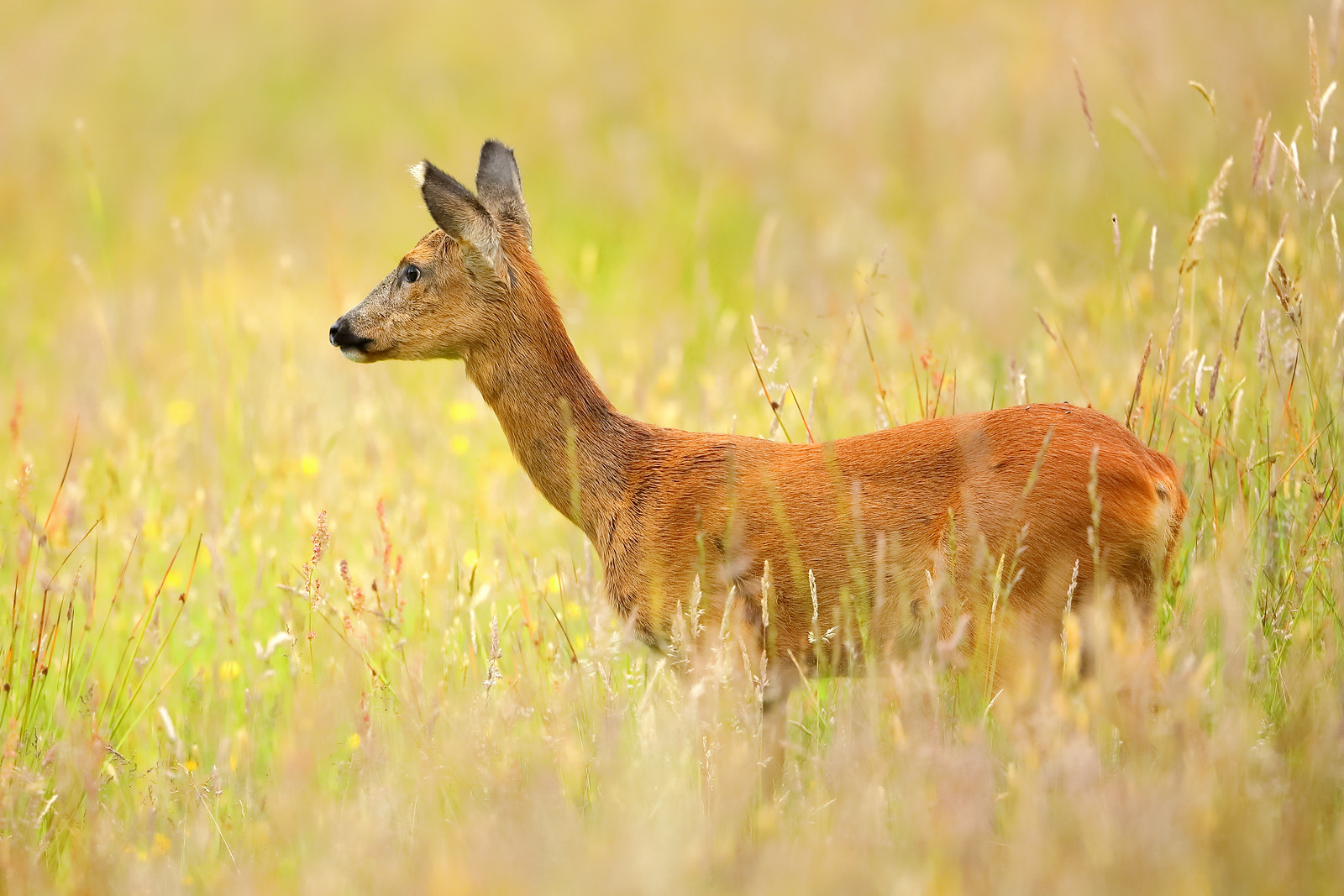
Showery weather didn't deter the doe I had been cultivating since early in the project from helping herself to more flowers and oak leaves. I've noticed she prefers to graze in the public fields and has not to my knowledge strayed into private land, except once into the field used for grazing horses. She spent a good few minutes observing something in the distance.

The Great Spotted Woodpecker chick seen on an earlier visit had flown the nest, but I had the privilege of photographing an adult and juvenile interacting in open sight on a nearby tree. The adult was clearly trying to teach their offspring survival skills and they were so preoccupied, that the photographer standing nearby was an irrelevance. I must remember next year to visit the nature reserve earlier into May to see more of the woodpeckers.
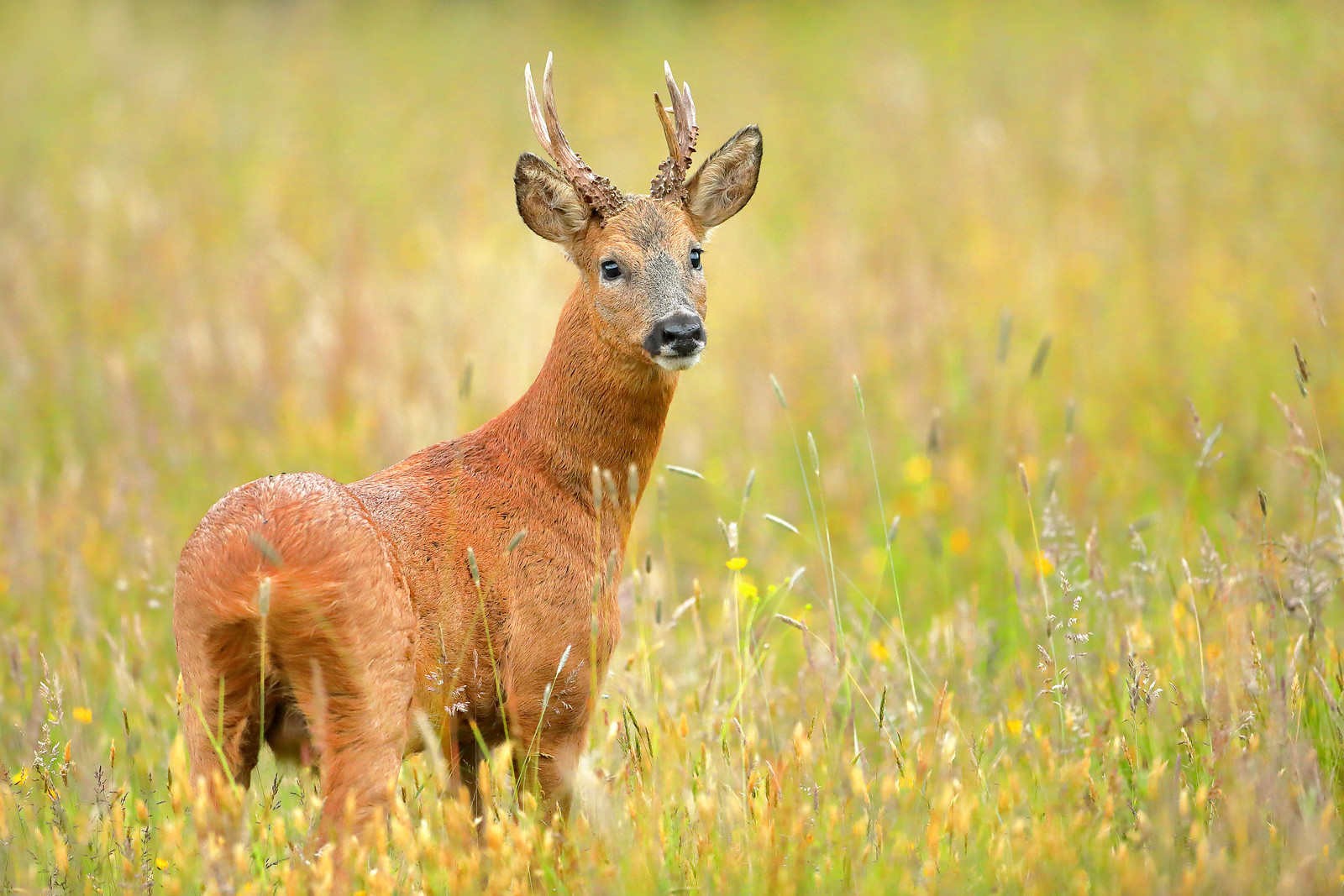
The mature roe buck seen earlier in the evening had sat down in the meadow, so I positioned myself in hope he would get up at the anticipated time to begin grazing. I waited and waited and waited, before heading back to where I had chained my bike. Then the King of the Meadow rose at precisely 21:23 and 43 seconds. The light by this time had become so poor, that I knew the image would require a little more adjustment than normal to get it looking right. Viewing the image on my camera LCD, I recognised the buck from last year. Unless I've just met his twin brother, it's him. If you look at the periphery of his ears and the black markings around the nose, they are exactly the same. Another year older, he is stockier and the new antlers are more developed. Even his body language is the same.

If I lived nearby, I could have visited the nature reserve more often and told a far more complete story than I possibly could through these often arduous long distance cycle journeys. I've clocked up 260 miles on long ascents and across bumpy and pot-hole riven asphalt. Some of these rides were in blazing hot sunshine, others in driving nighttime rain. The distance in a straight line is incidentally just four miles shy of Brighton to Barnard Castle, Durham. It's now time to finish the project, relax and pour out a glass of English chardonnay from the Kent Downs. But not before I've started the 2014 Rioja Reserva sitting on my wine rack.
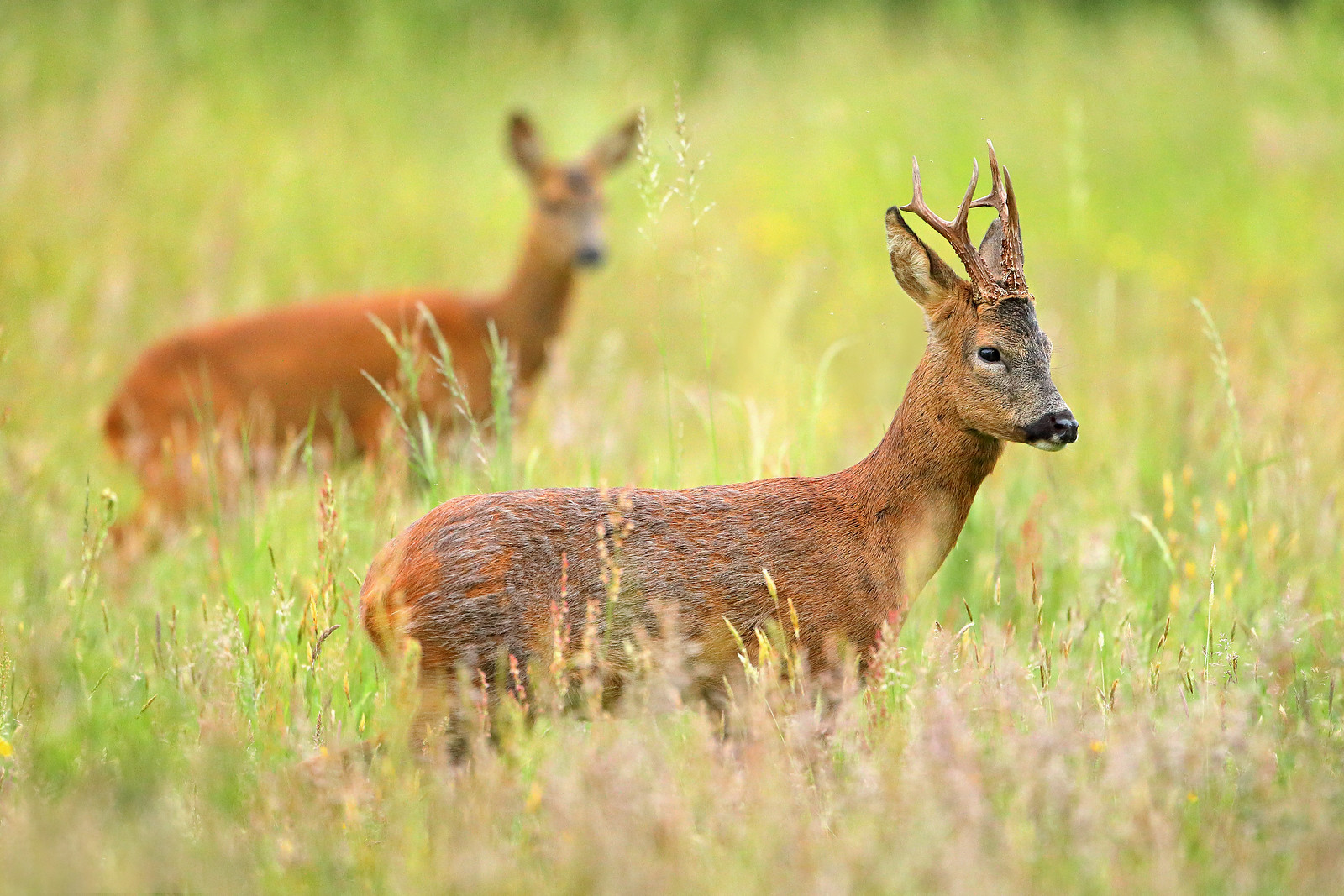





Comments
The cycle journey this year was almost as big as the photography project. When I look back, I can't believe I did all that cycling, but I really wanted to photograph the deer again. I missed out on the bluebells entirely, because of the strict lockdown and I would have been so disappointed had I not been allowed to travel for the deer. I'll be visiting the Knepp Estate next week for the butterflies, but the 40 mile round trip (already done recently) felt like a day off.
It's a shame I had to finish the project when I did, just as I was recording some interesting deer behaviour and movements, but I have to reserve energy for the butterflies now. The last thing I would have wanted was to pick up an injury and have to sit out July. I have some leave booked for the rutting season.
photography